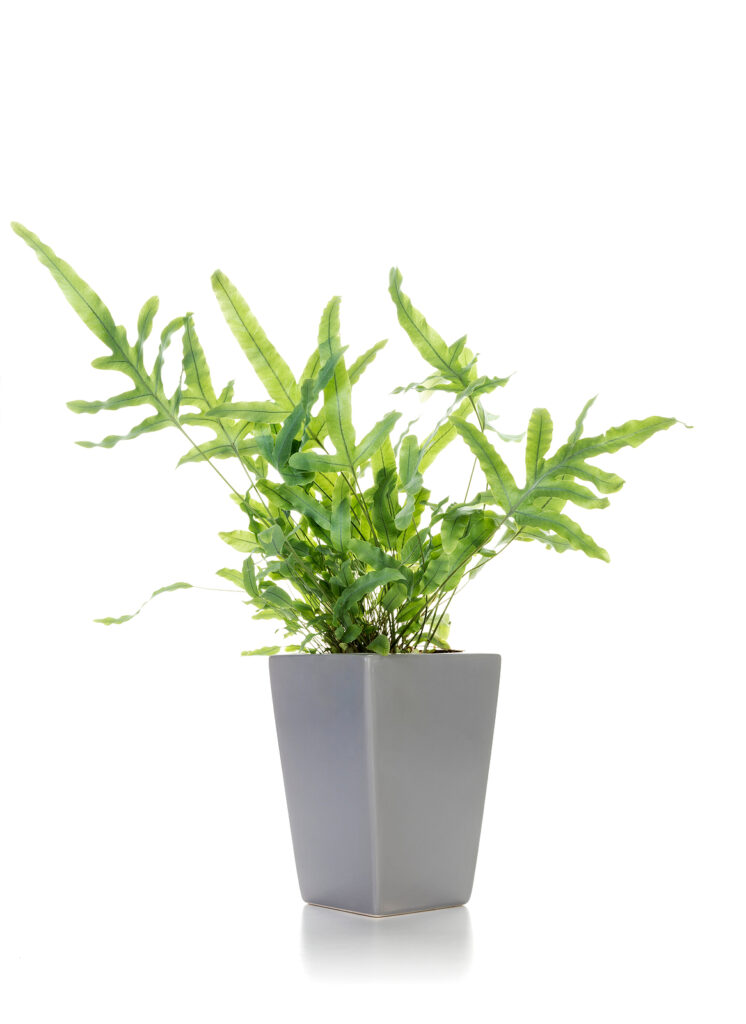Polypodium is a genus of ferns with deeply cut, arching fronds that may have a blue or gray cast. Polypodium are epiphytic ferns with furry, rust-colored stems that grow along the surface of the soil and resemble rabbits’ feet–thus the common name hare’s foot fern.
Polypodium fronds grow from 12 to 36 inches long. The fronds are triangular in shape; they can be deeply cleft, lobed, or ruffled.
Polypodium is a genus of about 75 species of mostly evergreen ferns native to tropical regions of the United States, Central, and South America. Hardy species can be grown in rock gardens, mixed borders, or along banks. Tender species should be grown in a greenhouse or as a houseplant.
Get to know Polypodium
- Plant type: Fern
- Growing zones and range: Zones 6-11 varies with species
- Hardiness: Half-hardy to tender depending on the species
- Temperature: Day, 60° to 75°F (16° to 24°C); night, 50° to 60°F (10° to 16°C). It does best in average room temperature with high humidity.
- Height and width: From 12 to 36 inches (30 to 91 cm) tall and about as wide.
- Foliage: Fronds are lance-shaped, simple or pinnate, occasionally further divied and borne at random in 2 rows
- Uses: Use hardy species as groundcover, rock garden; use tender species as a houseplent
- Common name: Hare’s foot fern, rabbit foot fern, polypody fern
- Botanical name: Polypodium
- Family name: Polypodiaceae
- Origin: Central and South America

Where to plant Polypodium
- Light outdoors: Grow Polypodium in full sun or dappled shade.
- Light indoors: Moderate to bright light, with direct winter sun, from northern or eastern exposure. Does well under artificial light, needing 12 light-hours daily. Hare´s – foot fern can be grown in bright light or under fluorescent light.
- Soil outdoors: Grow Polypodium in moderately fertile, humus-rich, gritty or stony, well-drained soil.
- Soil indoors: Fern mix, with good drainage.
When to plant Polypodium
- Set hardy species of Polypodim outdoors in spring or autumn.
Planting and spacing Polypodium
- Space Polypodium 12 to 36 inches (30 to 91 cm) apart.
How to water and feed Polypodium
- Water: Let the soil dry slightly between thorough watering
- Polypodium growing indoors should be misted twice daily. Polypodium prefers humidity of 50% to 80%.
- Feeding: Fertilize Polypodium every third or fourth watering during growing season with a mild liquid fertilizer.
Polypodium care
- Polypodium may rest during fall and winter, when it can be kept at 40°F (4°C). water sparingly; withhold fertilizer.

Growing Polypodium as a houseplant
- Polypodium can be grown in bright light or under fluorescent light.
- Polypodium grows best in average room temperature with high humidity.
- The soil should be allowed to dry to the touch between thorough waterings.
- Fertilizer can be applied monthly throughout the year.
Polypodium pests and diseases
- Check Polypodium for aphids, fungus gnats, mealybugs, scale, slugs, snails.
Polypodium propagation
- Propagate Polypodium by dividing rhizome sections orspores.
- Plant rhizome division in a potted in a fern soil mix.
Polypodium varieties to grow
- Polypodium aureum (Phlebodium aureum), hare’s foot fern, golden polypody. Native to tropical America, including Florida. Heavy, brown, creeping flattened rhizomes with brown or rust-colored scales; coarse blue-green fronds 3 to 5 feet long; ronds drop if hit by frost, but plants recover fast. Cultivar ‘Mandaianum’, sometimes called lettuce fern, has frilled and wavy frond edges.
- P. cambricum, southern polypody. Lance-shaped to broadly triangular mid-green fronds to 24 inches long.
- P. punctatum, also listed as P. polycarpon, has light green, leathery leaves which may be ruflled, fringed, or forked at the tips.
- P. scolopendria has creeping, fleshy rhizomes; leathery leaves are lobed.
- P. subauriculatum ‘Knightiae’ (Goniophlebium subauriculatum ‘Knightiae’),Knight’s polypody. Gracefully drooping fronds to 3 feet or longer, with fringed edges.



